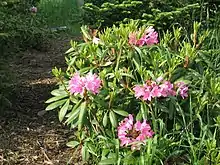Great Balsam Mountains
The Great Balsam Mountains, or Balsam Mountains, are in the mountain region of western North Carolina, United States.[1][2] The Great Balsams are a subrange of the Blue Ridge Mountains, which in turn are a part of the Appalachian Mountains. The most famous peak in the Great Balsam range is Cold Mountain, which is the centerpiece of author Charles Frazier's bestselling novel Cold Mountain.
| Great Balsam Mountains | |
|---|---|
.jpg.webp) Great Balsam Mountains as seen from the Blue Ridge Parkway | |
| Highest point | |
| Peak | Richland Balsam |
| Elevation | 6,410 ft (1,950 m) |
| Coordinates | 35°22′N 82°59′W |
| Dimensions | |
| Length | 21 mi (34 km) |
| Width | 18 mi (29 km) |
| Geography | |
| Country | United States |
| State | North Carolina |
| Parent range | Appalachian Mountains |
| Geology | |
| Type of rock | gneiss |
The Blue Ridge Parkway runs along its length and at Richland Balsam (milepost 431), the Parkway is at its highest point (6053 feet).
Peaks
.jpg.webp)
- Richland Balsam – 6410 feet
- Black Balsam Knob – 6214 feet
- Mount Hardy – 6120 feet
- Reinhart Knob – 6080 feet
- Grassy Cove Top – 6040 feet
- Tennent Mountain – 6040 feet
- Sam Knob – 6040 feet
- Cold Mountain – 6030 feet
- Shining Rock – 6040 feet
- Chestnut Bald
("Mountain heights". Peakbagger.com.)
Other landmarks
- Balsam Gap
- Devil's Courthouse
- Judaculla Rock (see Tsul 'Kalu; photos[3])
- Tanasee Bald (see Tsul 'Kalu)
Flora
The area consists of a transition forest between the southern Appalachian spruce–fir forest (which resembles forest types found at northern latitudes) and the mixed deciduous forests of temperate America.[4]
Trees
The following trees are at higher elevations:
- Fraser fir[5] ("balsams" or "She balsams"). Forests of these trees appear black from a distance; however, these trees are declining due to the balsam woolly adelgid.[6]
- Red spruce[7] ("He balsams"). The red spruce is distinguished from the Fraser fir by having bark whose rosin cannot be milked (hence, "He balsams") and by having hanging cones.
See also
Sources
- "Great Balsam Mountains". Geographic Names Information System. United States Geological Survey, United States Department of the Interior.
- "Great Balsam Mountains". Peakbagger.com. Retrieved 2007-07-17.
- "Judaculla". Archived from the original on 2007-08-14. Retrieved 2007-07-19.
- Sutton, Myron; Sutton, Ann (1985). Eastern forests (Audubon Society Nature Guides). New York: Knopf. ISBN 0-394-73126-3. p43
- USDA, NRCS (n.d.). "Abies fraseri (Fraser fir)". The PLANTS Database (plants.usda.gov). Greensboro, North Carolina: National Plant Data Team. Retrieved 15 June 2022.
- Frankenberg, Dirk (2000). Exploring North Carolina's Natural Areas: Parks, Nature Preserves, and Hiking Trails. Chapel Hill: University of North Carolina Press. ISBN 0-8078-4851-4. p343
- USDA, NRCS (n.d.). "Picea rubens (red spruce)". The PLANTS Database (plants.usda.gov). Greensboro, North Carolina: National Plant Data Team. Retrieved 15 June 2022.
- USDA, NRCS (n.d.). "Rhododendron calendulaceum (flame azalea)". The PLANTS Database (plants.usda.gov). Greensboro, North Carolina: National Plant Data Team. Retrieved 7 June 2022.


